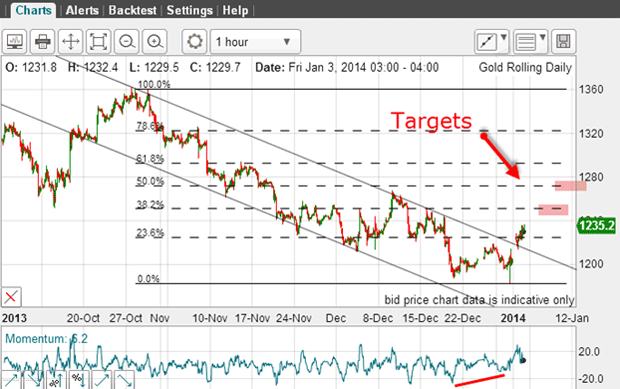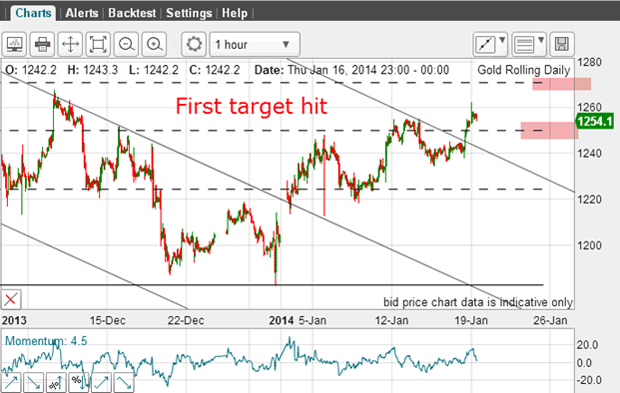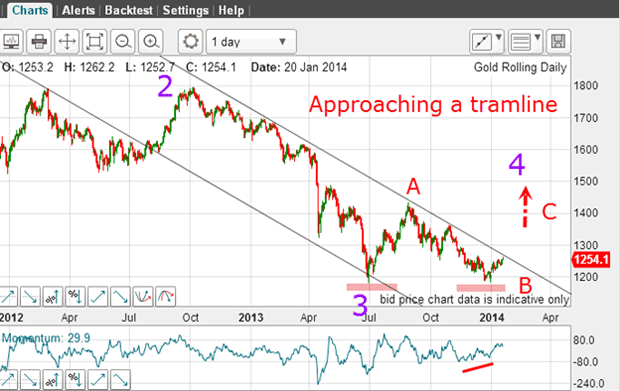The gold price hits my target in the charts
Your price target hit, do you sell out and take profits, or stay in hoping for more? John C Burford explains how the charts can help you decide.
It's always satisfying when one of my targets is hit. But my problems don't end there - they multiply. Decisions have to be made about how to manage the trade, which is one of the hardest aspects of swing trading. Trade management is one of the essential elements of being a successful trader.
You can have the finest trade-entry system in the world, but if your trade management is faulty you will most likely be unsuccessful.
The question is this: Do I take profits at the target or hold on to the position? And if I hold, can I come up with another logical target?
MoneyWeek
Subscribe to MoneyWeek today and get your first six magazine issues absolutely FREE

Sign up to Money Morning
Don't miss the latest investment and personal finances news, market analysis, plus money-saving tips with our free twice-daily newsletter
Don't miss the latest investment and personal finances news, market analysis, plus money-saving tips with our free twice-daily newsletter
One of the deadly sins of trading
Of course, this is often when the market reverses and takes that trade out for a loss that usually exceeds the profit on the first trade!
This type of trading is one of my deadly sins. It's called emotional trading'.
The other problem arises if I decide to hold. I do not want to see the market reverse and see my lovely paper profit disappear, which could happen.
You see, things can get very emotional in the trade management phase and this is the most dangerous part of trading. It's the battle in your mind between greed and fear the classic encounter we all have to deal with.
To be a long-time winner in the markets, you must have your emotions under control. Yes, we are all human and feel the same emotions when trading. But it is those who can act against their basic emotions that succeed.
An emotional display is good at weddings and in the movies, but not in your trading room.
Proof that my tramline method works
gold was making a rally attempt

My first target is the Fibonacci 38% level. This is the picture this morning:

I have drawn in my third tramline, which I can now do in light of the original upper tramline break. Last week's rally took the market to my target and crucially made a hit on my third tramline. This tramline hit is another justification for using my tramline method. That's because it often gives a very accurate price target where short-term profits can be taken.
Notice how the market bounced down off this third tramline as it respected the resistance provided by the line. But the market did not decline far from there. Instead, it staged a further sharp rally to move up above the resistance of the tramline. This morning, the market has made a new high for the move in the $1,260 area.
If this consolidation holds, then my next target is the upper pink zone, which is the Fibonacci 50% retrace. If it does reach this level, then it should encounter very stiff resistance. That's because the 50% level is a very common turning point (as is the 62% level).
Why gold is one of the most emotional markets

This is the massive leg down off the October 2012 high at $1,800 with the famous plunge low last summer to the $1,180 level. Then we saw a vigorous relief rally to the September high. After that, there was the move down to the recent $1,180 low. That sets up the possibility of a double bottom, which I pointed out before.
I have applied the Elliott wave (EW) labels that I believe are operating. It is the correct EW labels for the move off the June 2012 low (which is certainly wave 3) that is in question, and I have made one valid attempt by assuming an A-B-C pattern.
If we are in a large A-B-C off the wave 3 low, then a reasonable target would be the A wave high at the $1,430 area a good $170 above the current market. That would make a very nice trade.
If this is a realistic target, then to get there the market would have to punch through my upper tramline and that is not a given, although it is only a handful of dollars away as I write.
Interestingly, in January I have noted a sharp increase in bullish comments on gold. Some commentators are saying that it is back in a bull trend and to look for a huge rally. No doubt, many of these are written by hard-hit bulls who are hoping and praying for a come-back. Remember, gold did not have a friend a few weeks ago.
It is amazing how a small $70 rally can re-kindle the glittering hopes of die-hard gold bulls. This proves that the gold market is one of the most emotional on the board.
Even so, in the short-term, the path of least resistance is a dip back to the lower tramline in a kiss. But if not, then the market should make an assault on my Fibonacci 50% target at the $1,270 level.
Get the latest financial news, insights and expert analysis from our award-winning MoneyWeek team, to help you understand what really matters when it comes to your finances.
John is is a British-born lapsed PhD physicist, who previously worked for Nasa on the Mars exploration team. He is a former commodity trading advisor with the US Commodities Futures Trading Commission, and worked in a boutique futures house in California in the 1980s.
He was a partner in one of the first futures newsletter advisory services, based in Washington DC, specialising in pork bellies and currencies. John is primarily a chart-reading trader, having cut his trading teeth in the days before PCs.
As well as his work in the financial world, he has launched, run and sold several 'real' businesses producing 'real' products.
-
 Why UK investors are backing British stocks in 2026
Why UK investors are backing British stocks in 2026The UK stock market may be lacking fashionable technology shares but investors are keen to buy British next year
-
 UK inflation live: Inflation fell to 3.2% in November
UK inflation live: Inflation fell to 3.2% in NovemberA rise of 3.2% in CPI inflation in the 12 months to November undershoots almost all expectations